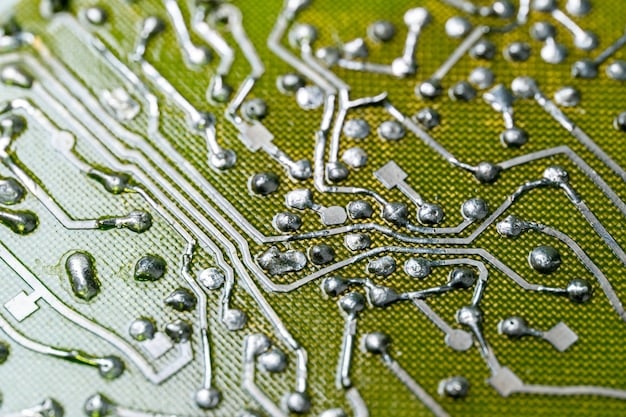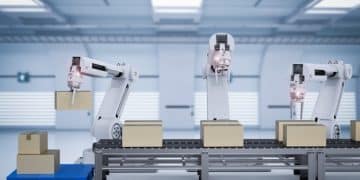Innovation’s Role in US Economic Growth: Emerging Technologies

Innovation plays a pivotal role in driving US economic growth by fostering productivity, creating new industries, and enhancing competitiveness, particularly through the adoption and development of emerging technologies.
The United States has long been a global leader in innovation, and this continues to be a critical driver of its economic prosperity. From the development of the internet to advancements in biotechnology, innovation, particularly in emerging technologies, has consistently reshaped industries and fueled growth.
The Historical Impact of Innovation on the US Economy
Innovation has been a cornerstone of US economic growth since the Industrial Revolution. It leads to increased productivity, new jobs, and improved living standards. Throughout history, breakthroughs like the assembly line, the telephone, and the personal computer have revolutionized industries and reshaped the economic landscape.
Key Innovations in US History
Several innovations stand out in their transformative impact on the US economy. These advancements not only created entirely new sectors but also significantly enhanced existing industries.
- The Assembly Line: Revolutionized manufacturing by enabling mass production, making goods more affordable and accessible to the average consumer.
- The Telephone: Transformed communication and facilitated business operations, leading to increased efficiency and interconnectedness.
- The Personal Computer: Democratized access to information and computing power, fostering entrepreneurship and driving productivity across various sectors.
- The Internet: Ushered in the digital age, creating new industries, transforming communication and commerce, and fostering global connectivity.
These innovations have consistently propelled the US economy forward, demonstrating the power of transformative ideas and technologies.
In summary, the historical impact of innovation on the US economy is undeniable. From manufacturing to communication, breakthroughs have consistently spurred growth and improved living standards, underscoring the importance of fostering an environment conducive to innovation.
Emerging Technologies Driving Current Economic Growth
Today, several emerging technologies are poised to drive the next wave of US economic growth. These include artificial intelligence, biotechnology, nanotechnology, and renewable energy. Their potential to disrupt industries and create new markets is immense.

Artificial Intelligence (AI)
AI is transforming industries by automating tasks, improving decision-making, and creating new products and services. Its impact spans sectors such as healthcare, finance, and transportation.
Biotechnology
Biotechnology is revolutionizing healthcare, agriculture, and manufacturing. Advances in gene editing, personalized medicine, and biomanufacturing are creating new opportunities for economic growth and improved quality of life.
Emerging technologies like AI and biotechnology are reshaping multiple sectors, presenting opportunities for increased efficiency, new product development, and economic growth. Their widespread adoption and continued development are crucial for maintaining US competitiveness and driving future prosperity.
The Role of Government in Fostering Innovation
Government policies play a crucial role in fostering an environment conducive to innovation. This includes funding research and development, providing incentives for entrepreneurship, and creating a regulatory framework that encourages innovation while protecting consumers and the environment.
Government Funding for R&D
Government funding for research and development is essential for supporting basic research and technological advancements. Agencies like the National Science Foundation (NSF) and the National Institutes of Health (NIH) play a critical role in funding cutting-edge research.
Incentives for Entrepreneurship
Policies that encourage entrepreneurship, such as tax incentives for startups and streamlined regulatory processes, can help foster a vibrant ecosystem for innovation. Small businesses and startups are often at the forefront of developing and commercializing new technologies.
Creating a Supportive Regulatory Framework
A well-designed regulatory framework can promote innovation while addressing potential risks and ensuring consumer protection. This includes striking a balance between encouraging innovation and regulating emerging technologies to mitigate potential harms.
Government policies are vital for fostering innovation through funding, incentives, and a supportive regulatory environment. These interventions help create an ecosystem where new ideas can flourish, driving economic growth and societal progress.
Private Sector Investment in Innovation
Private sector investment is a critical component of the innovation ecosystem. Companies invest in research and development, new technologies, and process improvements to maintain their competitiveness and drive growth. Venture capital firms also play a key role by providing funding and support to startups with high-growth potential.

Corporate R&D
Large corporations invest heavily in research and development to create new products, improve existing ones, and gain a competitive edge. These investments often lead to breakthroughs that transform industries.
Venture Capital
Venture capital firms provide funding to early-stage companies with innovative ideas and high-growth potential. This funding helps startups develop new technologies and scale their businesses.
Private sector investment, through corporate R&D and venture capital, plays a pivotal role in driving innovation and economic growth. These investments fuel the development and commercialization of new technologies, creating jobs and enhancing competitiveness.
The Impact of Innovation on Job Creation
Innovation leads to the creation of new jobs and industries, while also transforming existing ones. Emerging technologies create demand for skilled workers in fields such as data science, software engineering, and biotechnology. These new jobs often offer higher wages and better opportunities for advancement.
New Industries and Occupations
Innovation creates entirely new industries and occupations that did not exist before. For example, the rise of the internet led to the creation of new jobs in web development, social media, and e-commerce.
Transforming Existing Jobs
Innovation also transforms existing jobs by automating routine tasks and enhancing productivity. This can lead to increased efficiency and higher wages for workers.
Innovation spurs job creation by generating new industries and transforming existing ones. This shift necessitates a skilled workforce, underscoring the importance of investing in education and training to prepare workers for the jobs of the future and ensure continued economic growth.
Challenges and Opportunities in the Innovation Ecosystem
While innovation offers tremendous opportunities for economic growth, it also presents several challenges. These include the need for skilled workers, the potential for job displacement, and the ethical and social implications of emerging technologies. Addressing these challenges is essential for ensuring that innovation benefits society as a whole.
Skills Gap
The rapid pace of technological change requires workers to continuously update their skills. The skills gap, or the mismatch between the skills employers need and the skills workers possess, is a significant challenge.
Job Displacement
Automation and AI have the potential to displace workers in certain industries. Addressing this challenge requires investing in retraining programs and creating new opportunities for displaced workers.
Ethical and Social Implications
Emerging technologies raise important ethical and social questions. It is important to consider the potential impacts of these technologies on privacy, security, and social equity.
Addressing the challenges in the innovation ecosystem, such as the skills gap, job displacement, and ethical considerations, is crucial. By proactively managing these issues, the US can harness the full potential of innovation, ensuring that its benefits are widely distributed and contribute to sustained economic growth.
| Key Point | Brief Description |
|---|---|
| 💡 Historical Impact | Innovation has consistently driven US economic growth since the Industrial Revolution. |
| 🚀 Emerging Tech | AI, biotech, and renewable energy are key technologies poised to drive future growth. |
| 🏛️ Govt’s Role | Government fosters innovation through funding, incentives, and supportive regulations. |
| 🧑💼 Private Sector | Corporate R&D and venture capital are vital for fueling innovation and economic expansion. |
Frequently Asked Questions
▼
Innovation drives economic growth by boosting productivity, creating new industries, and enhancing global competitiveness. Emerging technologies are key components.
▼
AI, biotechnology, nanotechnology, and renewable energy are significant contributors, disrupting industries and fostering the creation of new markets and opportunities.
▼
The government supports innovation through funding for R&D, offering incentives for entrepreneurship, and establishing regulatory frameworks that encourage technological advancement.
▼
Key challenges include addressing the skills gap, managing job displacement due to automation, and navigating the ethical implications of emerging technologies for society.
▼
Private sector investment, primarily through corporate R&D and venture capital, is crucial for commercializing new technologies and driving innovation, leading to new jobs.
Conclusion
In conclusion, innovation is an indispensable engine of US economic growth, with emerging technologies at the forefront. By fostering a supportive ecosystem that encourages investment, addresses challenges, and promotes collaboration between government, private sector, and academia, the United States can harness the full potential of innovation to drive prosperity and improve the lives of its citizens. The ongoing development and adoption of these technologies are crucial for maintaining a competitive edge in the global economy.





